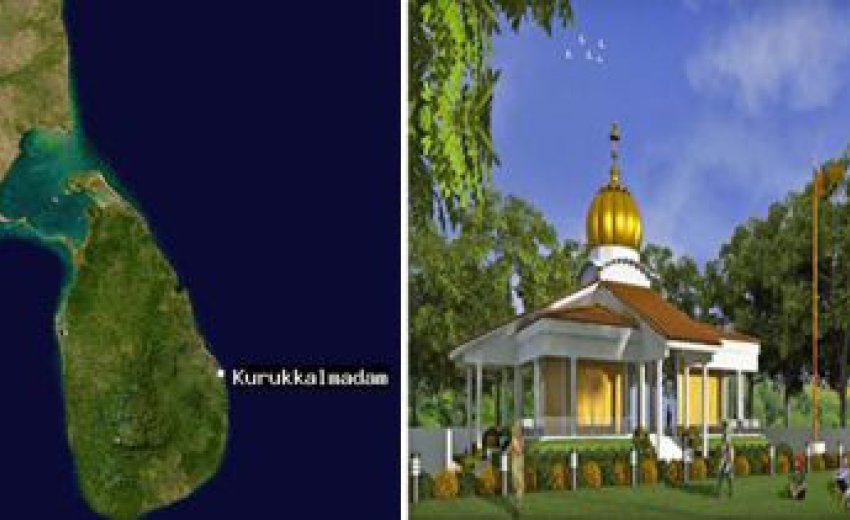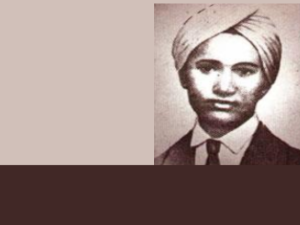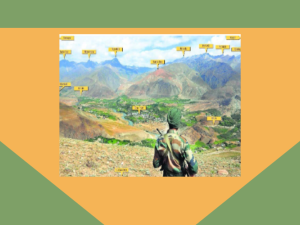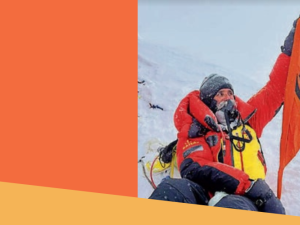FOOTPRINTS OF GURU NANAK’S TRAVELS IN SRI LANKA
PART II
From the evidence above the places and times of visits and the route adopted were not clear. Records were further evaluated to locate these facts. Since Bhai Paira, Gyani Gyan Singh, Dr Kirpal Singh, Dr Ashok Kainth, S. Sarvjeet Singh Modi and others had visited Sri Lanka and recorded some evidence about Guru Nanak's visit their accounts were checked for further evidence.
Haqiqat Rah Muqim Raje Shivnabh Ki[20] (account or description of way, i.e. journey to the abode of Raja Shivnabh) is a short piece of simple prose about 200 words in length, found appended to some manuscript copies of Sri Guru Granth Sahib, particularly to copies of the Bhai Banno recension.
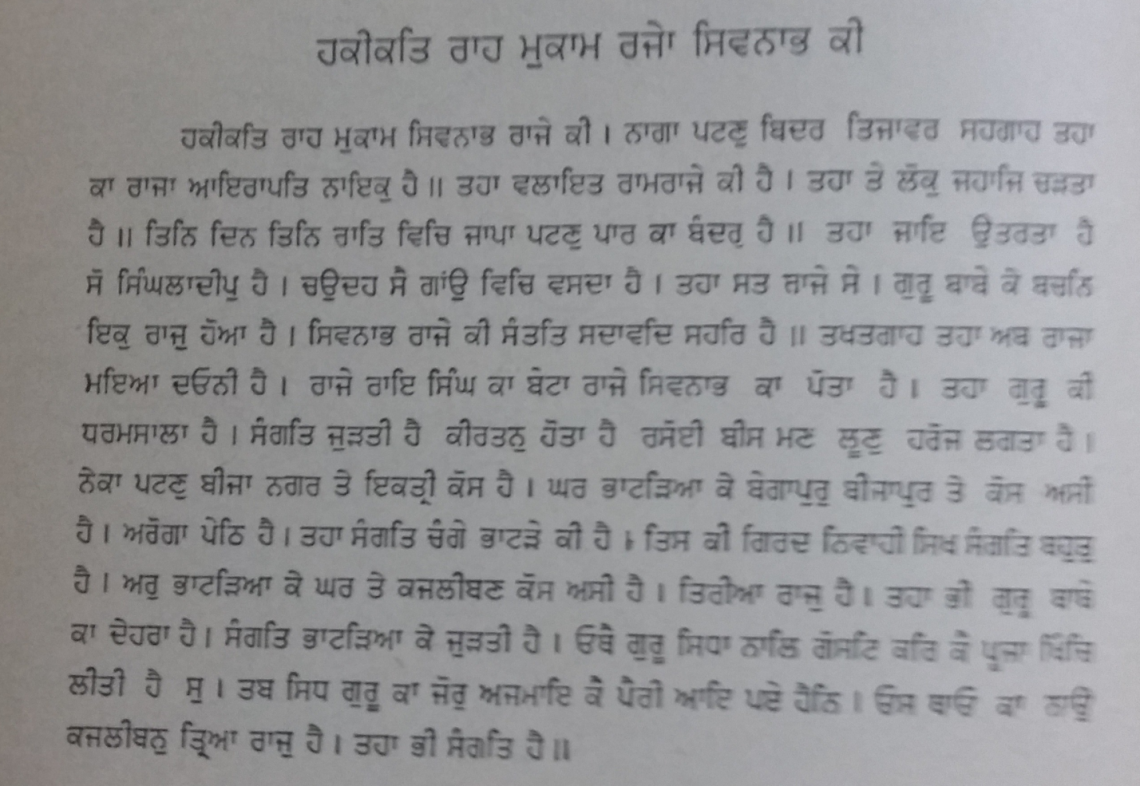
According to Bhai Mani Singh, Sikhan di Bhagat Maal, Guru Arjan sent Bhai Paira to Ceylon (Sri Lanka) in search of a manuscript, Pran Sangali, (Chain of the Vital Breath), an interpretation of Hatha Yoga, which was said to have been recited by Guru Nanak to the Raja of Sanghladip, Shivnabh. Bhai Paira brought the manuscript but it was discarded by Guru Arjan as corrupted. The account Bhai Paira gave of his travels was recorded by Bhai Banno, another scholarly Sikh of the time and is a sort of guide to travel, by ship to Sinhaladeep, from the mainland of the Indian subcontinent and to locate the place of the Raja in that land. The language is a mixture a Sadh Bhakha and Punjabi.
The author mentions some place-names with their distance from each other in some cases. It is also mentioned that there existed a number of Sikh congregations (sangats) in those days in South India and Sri Lanka. The details of route to Sri Lanka are given as follows: "Nagaptnam, Bidar to Tanjore city. Their king is lyerapat Nayak. There is the dominion of the King Rama. There from the people embark on the ships. It takes three days and three nights to Japapatan (Jaffnapatam) a port on the other side. There they disembark. That is Singhaladesh (Sri Lanka). It has 14,000 villages. There were seven kings but with the blessing of the Guru it is now a united kingdom. The descendants of the king Shivnabh live at Setavad (Setavak). The present king is Mayadunne who is the son of Rai Singh and grandson of Raja Shivnabh. There is a Dharamsala of the Guru..."
From the above we find that
- The route to Sri Lanka then included Nagaptnam, Bidar and Tanjore city.
- King in Tanjore (Tanjvur) then was lyerapat Nayak. His kingdom was a Ram Rajya.
- From Tanjore the people embarked on the ships to Sri Lanka.
- It took three days and three nights to Japapatan (Jaffnapatam) a port on the other side. There they disembark.
- Singhaladesh (Sri Lanka) had14,000 villages.
- There were seven kings in Sri Lanka then.
- With the blessing of the Guru it became a united kingdom when Bhai Paira went there.
- The descendants of the King Shivnabh live at Setavad (Setavak). The present king is Mayadunne who is the son of Rai Singh and grandson of Raja Shivnabh.
- There is a Dharamsala of the Guru where the congregation (sangat) assembles, kirtan is performed and daily 20 maund of salt is used in the langar kitchen.
- A place Nekkapattan near Bijapur is also mentioned which has houses of Bhatda Sikhs. Also mentioned is Kajliban the place ruled by women. Guruji have defeated Sidhas in discussion. A congregation (sangat) used to be held there as well.
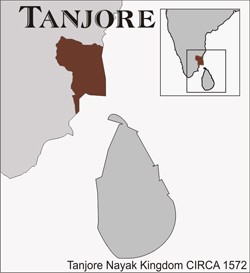 When Bhai Paira visited Sri Lanka, Tanjore (Thanjvur in Tamil Nadu) was a key city and kingdom of Nayaks as can be seen in the map [21] Route from Tanjore to Sri Lanka led to Jaffna or Jaffnapatnam or Japapatnam through Nagapatnam. Nagapattinam (nākappaṭṭinam, previously spelt Nagapatnam or Negapatam) is also a district headquarter town in the Indian state of Tamil Nadu.
When Bhai Paira visited Sri Lanka, Tanjore (Thanjvur in Tamil Nadu) was a key city and kingdom of Nayaks as can be seen in the map [21] Route from Tanjore to Sri Lanka led to Jaffna or Jaffnapatnam or Japapatnam through Nagapatnam. Nagapattinam (nākappaṭṭinam, previously spelt Nagapatnam or Negapatam) is also a district headquarter town in the Indian state of Tamil Nadu.Nagapattinam came to prominence during the period of Medieval Cholas (9th-12th century CE) and served as their important port for commerce and east-bound naval expeditions. The Chudamani Vihara in Nagapattinam constructed by the Sri Lankan king with the help of Chola kingdom is an important Buddhist structure of the times. This also shows close relationships between Sri Lanka and Tanjavur kingdom.[22]
Jaffna is the peninsula and capital city of the Northern Province of Sri Lanka. During the medieval times, the Kingdom of Aryachakravarti came into existence in the 13th Century as an ally to the Panadyan Empire in South India.[23] When the Pandyan Empire became weak due to Muslim invasions, successive Aryacakravarti rulers made the Jaffna kingdom independent and a regional power to reckon with in Sri Lanka.[24] However, it met with simultaneous confrontations with the Vijaynagar Empire that ruled from Vijaynagara, southern India, and a rebounding Kotte Kingdom from the southern Sri Lanka. [25] This led to the kingdom becoming a vassal of the Vijyanagar Empire as well as briefly losing its independence under the Kotte kingdom from 1450 to 1467. [26] The kingdom was re-established with the disintegration of Kotte kingdom and the fragmentation of Vijyanagara Empire.[26] It maintained very close commercial and political relationships with the Thanjavur Nayakar kingdom in southern India as well as the Kandyan and segments of the Kotte kingdom. This period saw the building of Hindu temples in the peninsula and a flourishing of literature, both in Tamil and Sanskrit.[25][26][27][28] Jaffna thus was the key city in the North Sri Lanka and had close links with Indian kingdoms and was also a commercial hub form trade between India and Sri Lanka.
Thanjavur was then under Nayaks during Guru Nanak's period and also during the period of visit of Bhai Paira. The route adopted was the general route as stated. The seven kingdoms as mentioned by Bhai Paira are explained below.
When Guru Nanak visited the place around 1511-1512 AD, Vijaybahu VII s/o Bhuvneka Bahu ruled over Kotte. He however did not have absolute control over Sri Lanka as other parts were ruled by other kings. These included Udarata kings Sennasamanta Vikrambahu (1469-1511A D) and his son Jayvira (1511- 1552 AD) who ruled Kandy area; Jaffna kingdom at Nallur under the King Pararajasekharan (1478-1519 AD) and the Vani principalities which extended from Jaffna borders along east coast to Yala and Panama in the south.[29] After the death of Vijaybahu VII, Kotte was divided into 4 kingdoms of 4 sons of Vijaybahu VII i.e., Bhuvanekabahu, Mayadunne (King of Sitwaka) and Raigama Bhandara.
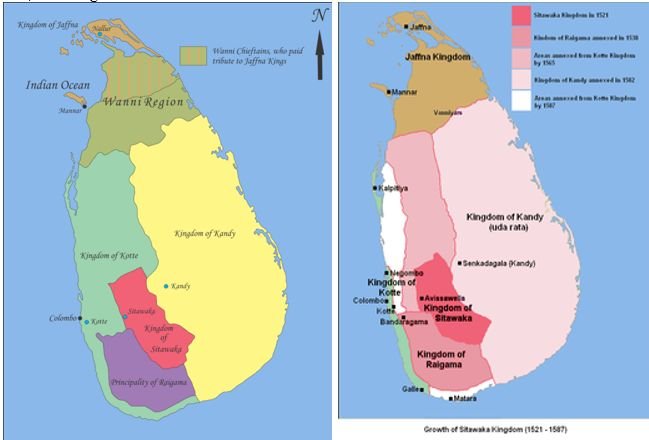 |
| 7 kingdoms of Sri Lanka in 16 century as claimed by Bhai Paira |
Out of these there were three fairly large kingdoms and several vassal states. The most prominent was the Sinhalese kingdom situated in the south-west with its capital at Kotte (near modern Colombo). The second Sinhalese kingdom, known as Kandyan, was situated on the central highland regions with its capital first at Gampola and later (after 1540 A.D.) at Kandy. The third was the Tamil kingdom in north Sri Lanka, which included Jaffna peninsula, the coastal areas as far as Mannar and many other adjacent islands with its capital at Nallur near Jaffna town. The vassal states, seven in number, were: Mullativa, Trincomalee, Batticola, Kottiyar, Palugana, Panam, and Yala. These were mostly found in Vanni district, south of Jaffna peninsula and along the eastern coast.
The names available of kings during the visit of Guru Nanak and Bhai Paira are as under[30]
1. House of Siri Sanga Bo (1412-1597)
(a) Parakramabahu VIII : Ambulagala Kumara, Son of Parakrama Bahu VI- 1484-1518 AD
(b) Dharma Parakramabahu IX (from Kelaniya), Son of Vira Parakrama Bahu VIII 1509-1528 AD
(c) Vijayabahu VII: Brother of Dharma Parakram Bahu IX, Rajah of Menik Kadavara- 1509-1521 AD
(d) Bhuvanekabahu VII: Eldest son of Vijaya Bahu, 1521-1551 AD
2. Kingdom of Sitawaka (1521-1593)
(a) Mayadunne (1521-1581) and his son Rajasinha I (1582-1593 AD):
Mayadunne: Brother of Bhuvaneka Bahu VII :Son of Vijaya Bahu VII, 1521-1581 AD
Mayadunne (1501-1581) was the king of Kingdom of Sitawaka in Sri Lanka who ruled for 60 years between 1521 and 1581.[31] He was the son of Vijay Bahu VII who reigned Kotte as king from 1509 to 1521. Mayadunne was the youngest child born to Vijaya Bahu VII and his main Queen. He had two full brothers, Bhuvanekabahu and Raigama Bhandara. In 1521 together with his brothers he revolted against his father, suspecting him of planning to pass the throne of Kotte to one of Vijaya Bahu VII's second queen's sons (Devaraja) after his death. Although Mayadunne was the youngest of the three brothers he was the mastermind behind this revolt which ended with the death of their father Vijaya Bahu VII (he was assassinated by a hired foreigner) and the Kotte Kingdom was divided between the three brothers. Bhuvanekabahu came to power as Bhuvanekabahu VII of Sri Lanka and got established in the Kotte kingdom with a region roughly including present day Colombo, Gampaha Districts, North Western Province and southern province coastline. Rajgama Bandara got established in Rajgama with his control roughly over present day Kalutara District & Southern Province except the coastline (which was under Kotte kingdom). Mayadunne got established in the Kingdom of Sitawaka (present day Avissawella) controlling roughly the modern day Sabaragamuwa province (Kegalle, Ratnapura Districts).
Mayadunne was a fierce opponent of the Portuguese, who had arrived on the Island in 1505. He devoted his whole life attempting to oust his brother Bhuvanekbahu, the king of Kottee and thereby preserve the independence of Lanka, which was being undermined by the Portuguese intrigue. He constantly invaded the territory of Bhuvanekabahu of Kotte[32].
Due to the fact that he stood against Portuguese invaders and stopping them from conquering the whole island, Mayadunne is considered one of the greatest kings of Sri Lanka who later united the whole kingdom of Sri Lanka. He died at the ripe age of 80 years in 1581 proving the statement of Bhai Paira that he united the kingdom with the blessing of Guru Nanak.
From the above it is clear that: 'There were seven kingdoms of Sri Lanka during the period of Guru Nanak's visit; foremost was the kingdom of Kotte'. Separate dynasty was ruling in Kandy, having broken away from Kotte and another separate kingdom of Jaffna in the North. Vijaya Bahu VI of Kotte, b: circa 1445, 1509-1524 AD was the king of Kotte, Sri Lanka's main kingdom. Vijaya Bahu VI of Kotte had three sons i.e., Bhuvaneka Bahu, Maha Raigam Bandara and Mayadunne from his first wife and Deva Raja Kumara from his second wife. Deva Raja Kumara was installed king by his father Vijaya Bahu VI of Kotte which annoyed the three elder brothers, who killed their father the king in anger and installed eldest son of Vijaya Bahu as King Bhuvaneka Bahu VII, b:circa 1475, 1524-1557 AD of Kotte. The other two brothers Maha Raigam Bandara and Mayadunne were given the rule of smaller states within Kotte. Later Mayadunne established King Mayadunne annexed much of the Kotte kingdom and was threatening the security of the capital city itself. Mayadunne was in power at the time of Bhai Paira.
From this available evidence all other statements are true except that names Rai Singh and Shivnabh could not be related to Mayadunne. Mayadunne was the youngest child born to Vijaya Bahu VII and not Rai Singh and was the grandson of Dharam Parkarmbahu (Bhuvneka Bahu) s/o Vir Parkaram Bahu- 1489-1509 AD and not Shivnabh. Whether the name of Vijaya Bahu VII was Rai Singh and the name of Dharam Parkarmbahu (Bhuvneka Bahu) s/o Vir Parkaram Bahu- 1489-1509 AD was Sivnabh needs further research.
Bhai Paira's note thus proves correct in all other points except the name of Mayadunne's grandfather was Shivnabh. Guru Nanak's visit to Sitwaka and Kotte and other areas around the kingdom also needs to be confirmed. However assuming Mayadunne's grandfather's name to be Shivnabh i.e., Parkarmbahu (Bhuvneka Bahu) s/o Vir Parkaram Bahu 1489-1509 AD, the period of visit of Guru Nanak has to be before 1509 AD which the chronicles do not confirm. if Guru Nanak visited Sri Lanka in 1510-1512 the king then was Vijaybahu s/o Bhuvneka Bahu 1509-1521 AD as given in Vanshavli/Sri Lanka Sinhala Royal Family Genealogy.[33][34][35][36][37][38]
Gyani Gyan Singh[39] has more details about Guru Nanak's visit to Sri Lanka since he visited it himself. After visiting Raskumara and mountains around, according to the wishes of Mardana, Guruji moved next to Singhladeep to redeem the beings. This island is also called Ceylon and Sri Lanka. He landed at Trincomalee after visiting the island…. ('Uthon agge Raskumara ate parbat ton hunde hoe Mardane di ichha anusar jeevan da udhaar karan vaste samundron paar Sangla deep vich ja fire, ese tapu nu Ceylon te Sri Lanka bhi aakhde han. Tapu di sair karde Tricnomalai ja utre.'). He also mentions Mattiakalam (Batticoloa) as the place of Shivnabh, Dibar (8 km in the North from Batticoloa), Swami Kartik Van near Khandi city on the bank of Manak Ganga, Badula, Ashok Vani (Noormali basti), Pushpalpur (Pushala) on the bank of Champa river, Bijaygarh, Lankagarh, Nagalpatti, Meghdambar Parbat, Japapattnam and back to Nagapatnam and Neelgiri Parbat in India.
Dr Kirpal Singh (1969)[40] in Janamsakhi Prampara mentions Guru Nanak's visit from Nagapatnam, Trincomalee, Batticaloa, Kurukalmadam, Kalmunae, Tiukoil, Patuvil, Panam, Katargama (Kartik Swami temple), Nuwara Eliya, Sitwaka (Aviswella) Kotte (Colombo), Anuradhapura, and Manar, Rameshwaram. Ashok Kumar Kainth, a Punjabi historian working in Sri Lanka, who claimed that he, along with other researchers, had recovered a 16th century inscription having reference to Guru Nanak's visit to Sri Lanka in 1511. Kainth, said, "28 pieces of inscription excavated near Batticoloa district of Sri Lanka, mentioned about talks between Guru Nanak and the then king of Lanka, Bikram Bahu VI. The inscription is in Sanskrit, Tamil and Gurmukhi script, which was a mixture of Sharda and Takri scripts of that time. Although the inscription is quite clear, two pieces (of the inscription) are yet to be excavated. It dates back to AD 1511," said Kainth, who worked as Arabic-Hindi translator in Kuwait court before moving to Sri Lanka in 2004.[41]
Another researcher Sarvjeet Singh Modi[42] wrote: 'A number of locations of gurdwaras were mentioned in Sikh chronicles and internet, but actually there is no gurdwara in Sri Lanka. and locations such as Battikola, Deebar, Koti, Kurukkalmadapam had nothing on record about gurdwaras as mentioned. We hired personal guide from each respective city and searched every place including the various churches, Hindu temples and mosques in order to locate gurdwaras. We even inquired at various libraries, record rooms, museums, police stations, post offices, GPOs and the respective Archeological Departments and had long conversation with local residents of each respective city, but there was no clue of any Gurdwara Sahib in Sri Lanka. We went to Colombo, the Capital of Sri Lanka. In Colombo there is a Sindhi Samaj Association, which has created a club. At the first floor of that club, they had done Prakash of Guru Granth Sahib Ji, along with other Hindu idols. They truly believe in Guru Nanak Sahib with full respect. We found no other Gurudwara there. We went to the archeological center of Colombo, where we consulted the director, who told us that there is a script of Guru Nanak Dev ji in Anuradh Pura museum (300 km away from Colombo). We also told that in District Kotte there was a copper plate with inscription "Nanak Acharya", honoring of Guru Nanak dev ji (and ascribed) by the people of Kotte. We searched for this copper plate, in various temples and museum of Kotte but we were not able to locate it. We found a village known as Mardana Nagar. It clicked to us that the city is might have been named on the name of Mardana ji, who accompanied Guru Nanak Dev ji everywhere. We discussed with the headman of Mardana Nagar but he was not clear about the history'.
The above accounts of Bhai Paira, Gyani Gyan Singh, Dr Kirpal Singh, Dr Kainth and Mr Modi were quite valuable. Guru Nanak's visit generally has been to the kingdoms and religious places. Since there were seven major kingdoms and 7 small kingdoms in Sri Lanka, indications are that Guru Nanak visited most of them. Also there were numerous ancient temples; some are given below most of which the Guru might have visited.
Places connected with Ram, Sita, Hanuman and Ravan e.g., Sitwaka, Nuwara Elliya, Gampola, Kandy, Kegall, Kotte, Katargama too might have been visited.
Dr Kainth and Mr Modi[41][42] searched for the place thoroughly but could not locate it. Mr Modi writes: "On internet, it was mentioned that at Deebar in Sri Lanka, there is a gurudwara, but when we reached there, there was no gurudwara. We researched a lot; enquired from local people and went to every single lane in Batticaloa to understand the truth. We found that there was a Hindu temple, where scholars disclosed that it was the place where Hanumanji's tail was put on fire when he came to Ravan's kingdom to rescue Sitaji but Hanuman Ji in turn burnt Sri Lanka".
Guru Nanak visited Kurukalmadam, next the details of which have been given by Dr. Kirpal Singh and Mr. Modi. Mr Modi visited the place along with Mr Ashok Kainth [41,42] and found that "Near Batticolova at Kurukkalmadapam evidence about Guru Nanak Dev's visit exists. When Guruji visited this place there was no village then. The village owes its name to Guruji. The tradition of the visit of a saintly missionary from the Punjab to that place is still well known to the local residents. According to a tradition Bhai Changa Bhatra belonged to this area. We visited Kurukkalmadapam and started looking for traces of visit all over the city. We reached every possible agency and all the local residents about the history of the place. We also went to every possible temple, mosque and church because their population is from Muslim and Hindu religions. These people mentioned of two Gurus visiting the place one in 1511 AD and one later.
We discussed this aspect with various local people who hesitated in the beginning but later as they got to know us and our work and opened up with us. They told us that there was a temple which was here since 100 years but the Dutch destroyed it, when they were in Sri Lanka and still the remaining of the temple were buried at that very place. Next day myself and my friend Brij Mohan Singh went to the temple in Kurukkalmadam and it was divine being in that temple. We went to a temple, and found a symbol of a flower inscribed on a silver plate which matched the symbol in the script we had found in the museum. We tried to figure out the importance of that symbol, from various scholars and priest of the temple. They told us that that the symbol is considered very religious and the people worship it whole heartedly.
The priest of the temple disclosed that there was a pond behind the temple. We went to the pond and were astonished by the strange attraction. That water of the pond was different… felt instincts of powerfulness. (That was the first time during my whole journey I felt instincts that were so powerful and peaceful). Main uss jal nu chakya bhi, tanh mainu vibration mehsus hui!! (I even tasted that holy sweet water and felt a vibration inside me).
Next day, near the pond I prayed to God ……and continued looking around that area. There was ….. a huge tree bearing small fruits similar to retha. We tried tasting that fruit, but local people stopped us from tasting it, they said it was poison. But we had faith in the power and we tasted it and it was a sweet (after the fact that retha is always considered sour, most bitter and such a product is used as a soap in other parts of the world). Finding the sweet retha was our biggest achievement…..we asked local persons, "Are there any more trees like this?" The reply was, "No this is the only one."
A gurdwara as shown below has now been planned at the site by Guru Nanak Sewa Trust which has been set up in Colombo. Dr Bajwa, S. Brijmohan Singh, Dr Chawla, Mr. Modi and S. Chaddha are actively working to set up a gurdwara at the site.
 |
| (left) Site and the Day and night view of the planned Gurdwara Proposal of a new gurdwara at Kurukalmandap. (center) Day view and (right). Night view |
Modi writes further[42]: "They gave us a book written by a Tamil resident of Sri Lanka. The book is about the history, community and religions of Sri Lanka. It also mentions that Guru Nanak Dev ji came to Sri Lanka in 1511. It says that later Nanak Gurunath visited Sri Lanka after 90-100 years. When we discussed this aspect with the author, he focused his words that, there were 2 Nanaks who came to Srilanka….But we explained him that it means Nanak Nath means "Nanak Guru Ka Nath" (Nanak Guru ka follower) and not Nanak Gurunath. The second was Bhai Paira whom he mentioned as Guru Nanak. It was clear that they confused Bhai Paira Ji as Guru Nanak. They were very much convinced. When we were to leave they presented us with a copy of the book written by the head of Kurukalmandpam. Images of the book written by the head of Kurukkalmadam are given below:
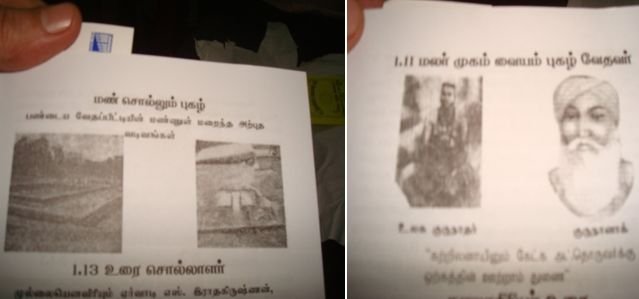 |
| Saravjit Singh Modi http://www.gurunanaksewatrust.org/about.html |
Dr Kainth and Mr Modi did not find any dharmsal at Sitwaka. There was no clue of any Sikh settlement either.
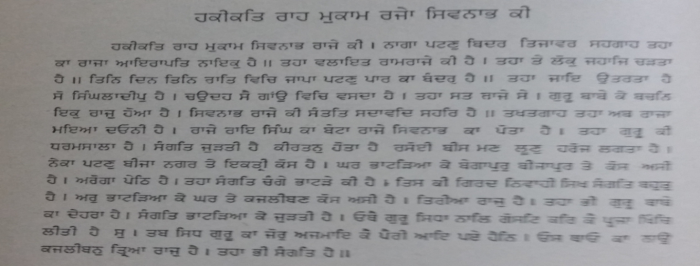
Mr Modi records: "… we went to AnuradhaPura Museum where Guru Nanak Dev ji went according to our Sakhiyan and where he debated and spread his message of humanity all around the district among the Buddhist (Buddh ghosht). There's a Buddhist Spoot, the biggest spoot in the world. We also discovered various Scripts, We found that there were bits of Punjabi language inscribed over them and we also found a script with Nanak written over it. We discovered that the script might contain 1400-1600 AD languages i.e Landa, Takri, Sharda, Gupta and Devagiri which were used in North India i.e Himachal Pradesh, Jammu & Kashmir, Punjab till Sindh. These languages were getting mixed during this period and Gurmukhi originated from the mix of these languages only. We are still working, over decoding the Script found in Sri Lanka.
We did our survey by going to various museums, morgue record points, various churches and mosques and unlimited temples. We also conducted Secondary Research, We googled about the various locations that where pointed containing gurudwara, we also visited such places and we found that there were no gurudwara in those areas and not even sikh families were residing there "We found these stone carvings from the Anuradhapra Museum and the other scripts we found are:
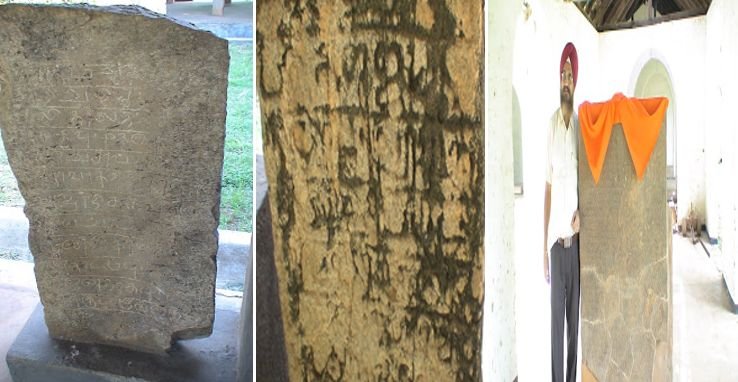 |
| Inscriptions in Anuradhpuram Museum |
From Anuradhapura, the Guru travelled towards Manar. The sea coast was relatively dry. The sandy dunes were spread all over and the water was rarely to be seen.[40]
======================================
References-II
20. https://www.thesikhencyclopedia.com/scriptures/bhai-gurdas-and-the-early...,
Walait Wali Janamsakhi, p.41-2 and Janamsakhi Bhai Mani Singh p.351, Ganda Singh Dr.(ed), The Punjab Past and Present, Vol III, 1969, Punjabi University, Patiala, Punjabi p. .12
21. Sri Lanka: largest cities and towns and statistics of their population, World Gazetteer.
22. Punch-marked coins called puranas that were current in India during the time of Buddha (6th to 5th centuries B.C.) and copper rods - "kohl" sticks that were very similar to the ones Egyptians used to paint with and dating back to 2000 B.C. - were discovered. Sir Paul E. Pieris, who conducted these excavations, expressed his conviction that the Northern part of Sri Lanka was a "flourishing settlement" even before the birth of Vijaya, the legendary founder of the Sinhalese eelavar.com, Early Jaffna.
23. e Silva, K.M.D (1981), A History of Sri Lanka, University of California, Berkley, ISBN 0-520-04320-0, p.91-92.
24. Peebles, Patrick (2006), The History of Sri Lanka, USA: Greenwood Press, ISBN 0-313-33205-3, p.31-33.
25. de Silva, A History of Sri Lanka, p.132-133
26. Peebles, History of Sri Lanka, p.34
27. Kunarasa, K The Jaffna Dynasty, p.73-75
28. https://www.google.co.in/?gfe_rd=cr&ei=Ay4kV8WNGuzH8AeHvY-AAg&gws_rd=ssl...
29. de Silva, K.M., 2005, A History of Sri Lanka, Vijita Yava Publications Sri Lanka, 4th edn Jan 2014, pp.144-145.
30. https://en.wikipedia.org/wiki/List_of_Sinhalese_monarchs
31. Codrington, Humphry William, A Short History of Sri Lanka: Dambadeiya and gampola Kings, 1215-1411 Lakdiva.org. Retrieved 2007-11-25. de Silva, K.M.D (1981), A History of Sri Lanka , University of California, Berkley, ISBN 0-520-04320-0, p.91-92.
32. de Silva, A History of Sri Lanka, p.132-133
33. Geiger Wilhelm, tr., 1912, The Mahawansa or Great Chronicle of Ceylon, Oxford: Oxford University Press
(for the Pali Text Society), p. 300. www.google.com
34. Dhammakitti; tr. Geiger, Wilhelm; tr. Rickmers, C. Habel (1212), Culavamsa: Being the most recent part of
35. Geiger, Wilhelm; Bode, Mabel Haynes, tr. 1912, Mahawansa or Great Chronicle of Ceylon, London: Oxford University Press
36. Gunasekara, B. ed., 1900, The Rajavaliya: or, A Historical narrative of Sinhalese kings from Vijaya to Vimala Dharma Surya II, Colombo: Government Printer, Ceylon. ISBN 81-206-1029-6.
37. Knox, Robert (1681), An Historical Relation of the Island Ceylon, London: Richard Chiswell.
38. Oldenberg, Hermann ed. & tr., 1879, The Dîpavaṃsa, an Ancient Buddhist Historical Record. Williams and Norgate.
39. Gyani Gyan Singh, Twareekh Khalsa, Janamsakhi Dasan Guruan ki, Guru 1 Bhag 1, pp.164-172
40. Kirpal Singh, 1969, Janamsakhi Prampra, Punjabi University, Patiala
41. http://timesofindia.indiatimes.com/india/Inscription-referring-to-Guru-N... Punjabi-historian/articleshow/21497495.cms
42. Saravjit Singh Modi http://www.gurunanaksewatrust.org/about.html
---------------------------------
Related Articles:
Footprints of Guru Nanak's Travels in Sri Lanka ~ Part I IV
In the Footprints of Guru Nanak: Visiting BrahmKund in Arunchal Pradesh
http://www.sikhnet.com/news/footprints-guru-nanak-visiting-brahmkund-arunachal-pradesh

